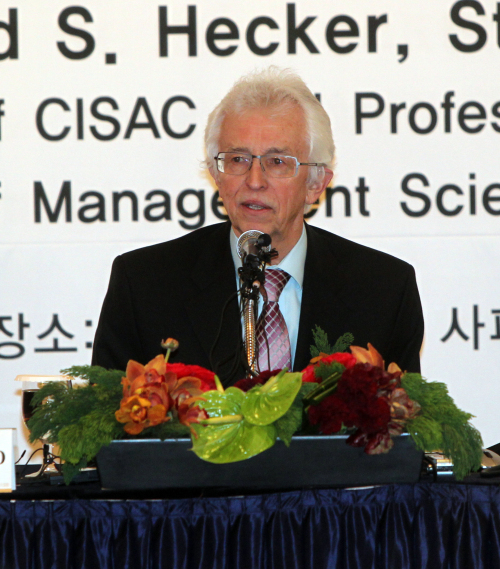Expert says Pyongyang has yet to miniaturize warhead for missiles
North Korea’s light water reactor is a safety concern because of the country’s lack of expertise in the area, according to U.S. scientist Siegfried Hecker, who first revealed the existence of North Korea’s uranium centrifuge facility to the world in November 2010.
“My largest concern is going to be the safety of that reactor. The light water reactor has very different critical requirements from gas-graphite reactors. And North Korea’s light water reactor has a different design,” Hecker, co-director of Center for International Security and Cooperation at Standford University, said at a forum in Seoul.
“They have no experience with this reactor. This is technically very difficult,” he said.
While the Western world has learned to work together to choose the right materials and construction methods, Pyongyang has not cooperated with the Western world, he said.
North Korea’s light water reactor is a safety concern because of the country’s lack of expertise in the area, according to U.S. scientist Siegfried Hecker, who first revealed the existence of North Korea’s uranium centrifuge facility to the world in November 2010.
“My largest concern is going to be the safety of that reactor. The light water reactor has very different critical requirements from gas-graphite reactors. And North Korea’s light water reactor has a different design,” Hecker, co-director of Center for International Security and Cooperation at Standford University, said at a forum in Seoul.
“They have no experience with this reactor. This is technically very difficult,” he said.
While the Western world has learned to work together to choose the right materials and construction methods, Pyongyang has not cooperated with the Western world, he said.

Mentioning the recent Fukushima disaster, Hecker said North Korea would not learn from the incident either.
North Korea’s emergency response and disaster management, as seen in past floods and droughts, are unreliable, he said.
On the timing of the completion of the LWR, Hecker, who believes the reactor is most likely intended for civilian use, said it will take at least two years.
“There is no way they can be ready by April of 2012.”
As for the status of North Korea’s nuclear program, he said North Korea has yet to miniaturize warheads to fit onto missiles.
“Speaking as a technical person, there is no question they have designs for miniaturized warheads. There are lots of designs that can be looked at on the Internet. Those do not make a miniaturized bomb,” Hecker said.
“The best way to gauge as to when North Korea will have that capability is to see when they do the next nuclear test.”
If the next nuclear test is successful, then within a few years time, they may be able to actually miniaturize a warhead and put it on a missile, Hecker said.
“They will probably need more tests, missile flight tests for sure.”
North Korea conducted two nuclear tests in 2006 and 2009.
In October 2010, North Korea unveiled the road-mobile Musudan intermediate-range ballistic missile during a military parade.
Hecker said the North has 24 to 42 kilograms of plutonium which could create four to eight nuclear bombs.
He said the six-party talks are the most effective way to reduce nuclear threats and urged regional powers to re-engage with Pyongyang to stop an escalation of the nuclear risk.
The scientist suggested that the U.S., South Korea, Russia, China and Japan take initial confidence-building measures by demanding a moratorium on missile and nuclear tests in return for what North Korea values.
He particularly urged a more active role from China.
“Preventing the North’s nuclear exports and cooperation with other nations will be an ongoing problem that requires aggressive enforcement by China,” he said.
While South Korean critics say China’s role is not satisfactory, South Korea needs to understand China’s point of view as well, he said.
“It’s an issue of coming to common ground with China.”
By Kim Yoon-mi (yoonmi@heraldcorp.com)
-
Articles by Korea Herald







![[From the Scene] Monks, Buddhists hail return of remains of Buddhas](http://res.heraldm.com/phpwas/restmb_idxmake.php?idx=644&simg=/content/image/2024/04/19/20240419050617_0.jpg&u=20240419175937)








![[From the Scene] Monks, Buddhists hail return of remains of Buddhas](http://res.heraldm.com/phpwas/restmb_idxmake.php?idx=652&simg=/content/image/2024/04/19/20240419050617_0.jpg&u=20240419175937)

![[KH Explains] Hyundai's full hybrid edge to pay off amid slow transition to pure EVs](http://res.heraldm.com/phpwas/restmb_idxmake.php?idx=652&simg=/content/image/2024/04/18/20240418050645_0.jpg&u=20240419100350)

![[Today’s K-pop] Illit drops debut single remix](http://res.heraldm.com/phpwas/restmb_idxmake.php?idx=642&simg=/content/image/2024/04/19/20240419050612_0.jpg&u=)